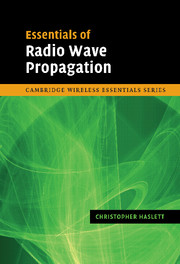Book contents
- Frontmatter
- Contents
- Preface
- Acknowledgements
- 1 Propagation in free space and the aperture antenna
- 2 Point-to-area transmission
- 3 The effect of obstacles
- 4 Reflection, scatter and penetration
- 5 Estimating the received signal strength in complex environments
- 6 Atmospheric effects
- 7 System design and interference management
- 8 Software-based tools
- 9 Summary
- Appendix 1 The decibel scale
- Appendix 2 Phasor arithmetic and phasor diagrams
- Appendix 3 Formula sheet
- Appendix 4 Explanation of the link budget
- Further reading
- References
- Recommendations of the Radiocommunication Bureau of the International Telecommunications Union (ITU), Geneva
- Author's biography
- Index
Preface
Published online by Cambridge University Press: 09 August 2009
- Frontmatter
- Contents
- Preface
- Acknowledgements
- 1 Propagation in free space and the aperture antenna
- 2 Point-to-area transmission
- 3 The effect of obstacles
- 4 Reflection, scatter and penetration
- 5 Estimating the received signal strength in complex environments
- 6 Atmospheric effects
- 7 System design and interference management
- 8 Software-based tools
- 9 Summary
- Appendix 1 The decibel scale
- Appendix 2 Phasor arithmetic and phasor diagrams
- Appendix 3 Formula sheet
- Appendix 4 Explanation of the link budget
- Further reading
- References
- Recommendations of the Radiocommunication Bureau of the International Telecommunications Union (ITU), Geneva
- Author's biography
- Index
Summary
The objective of this book is to allow the reader to predict the received signal power produced by a particular radio transmitter. The first two chapters examine propagation in free space for point-to-point and point-to-area transmission, respectively. This is combined with a discussion regarding the characteristics of antennas for various purposes. In chapter 3, the effect of obstacles, whether buildings or mountains, is discussed and analytical methods, whereby the strength of a signal is the shadow of an obstacle can be predicted, are presented. The following chapter investigates the nature of reflections and the effect that reflections have on the nature of a received signal. Chapter 5 shows how the level of a received signal can be predicted considering all propagation mechanisms. The many effects on a radio wave that are caused by precipitation and the structure of the atmosphere are explained in chapter 6. Chapter 7 demonstrates how knowledge gained can be used to design point-to-point radio links, broadcast systems, Earth–space systems and in-building systems. In chapter 8, the value of software tools in the planning of various radio networks is explained.
- Type
- Chapter
- Information
- Essentials of Radio Wave Propagation , pp. ix - xPublisher: Cambridge University PressPrint publication year: 2007



